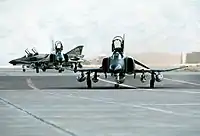Baghdad Pact
The Central Treaty Organisation (CENTO), originally known as the Baghdad Pact or the Middle East Treaty Organisation (METO), was a military alliance of the Cold War. It was formed in 1955 by Iran, Iraq, Pakistan, Turkey and the United Kingdom and dissolved in 1979.
 Flag | |
 CENTO members shown in green | |
| Abbreviation | CENTO |
|---|---|
| Formation | 24 February 1955 |
| Dissolved | 16 March 1979 |
| Type | Intergovernmental military alliance |
| Headquarters | Ankara |
Region served | Western Asia and Europe |
Membership | 5 states
|
US pressure and promises of military and economic aid were key in the negotiations leading to the agreement, but the United States could not initially participate. John Foster Dulles, who was involved in the negotiations as U.S. Secretary of State under President Dwight D. Eisenhower, claimed that was due to "the pro-Israel lobby and the difficulty of obtaining Congressional Approval."[1] Others said that the reason was "for purely technical reasons of budgeting procedures."[2]
In 1958, the US joined the military committee of the alliance. It is generally viewed as one of the least successful of the Cold War alliances.[3]
The organisation’s headquarters were in Baghdad, Iraq, in 1955 to 1958 and in Ankara, Turkey, in 1958 to 1979. Cyprus was also an important location for CENTO because of its location in the Middle East and the British Sovereign Base Areas on the island.[4]
History

Modeled after the North Atlantic Treaty Organisation (NATO), CENTO committed the nations to mutual cooperation and protection, as well as non-intervention in each other's affairs. Its goal was to contain the Soviet Union (USSR) by having a line of strong states along the USSR's southwestern frontier. Similarly, it was known as the 'Northern Tier' to prevent Soviet expansion into the Middle East.[5] Unlike NATO, CENTO did not have a unified military command structure, nor were many U.S. or UK military bases established in member countries, although the U.S. had communications and electronic intelligence facilities in Iran, and operated U-2 intelligence flights over the USSR from bases in Pakistan. The United Kingdom had access to facilities in Pakistan and Iraq at various times while the treaty was in effect.
On July 14, 1958, the Iraqi monarchy was overthrown in a military coup. The new government was led by General Abdul Karim Qasim who withdrew Iraq from the Baghdad Pact, opened diplomatic relations with Soviet Union and adopted a non-aligned stance. The organization dropped the name 'Baghdad Pact' in favor of 'CENTO' at that time.
The Middle East and South Asia became extremely volatile areas during the 1960s with the ongoing Arab–Israeli Conflict and the Indo-Pakistani Wars. CENTO was unwilling to get deeply involved in either dispute. In 1965 and 1971, Pakistan tried unsuccessfully to get assistance in its wars with India through CENTO, but this was rejected under the idea that CENTO was aimed at containing the USSR, not India.
CENTO did little to prevent the expansion of Soviet influence to non-member states in the area. Whatever containment value the pact might have had was lost when the Soviets 'leap-frogged' the member states, establishing close military and political relationships with governments in Egypt, Syria, Iraq, the People's Democratic Republic of Yemen, Somalia, and Libya. By 1970, the USSR had deployed over 20,000 troops to Egypt, and had established naval bases in Syria, Somalia, and South Yemen.
The Iranian revolution spelled the end of the organization in 1979, but in reality, it essentially had been finished since 1974, when Turkey invaded Cyprus. This led the United Kingdom to withdraw forces that had been earmarked to the alliance,[6] and the United States Congress halted military aid to Turkey despite two Presidential vetoes.[5] With the fall of the Iranian monarchy, whatever remaining rationale for the organization was lost. Future U.S. and British defence agreements with regional countries—such as Pakistan, Egypt, and the Persian Gulf states—were conducted bilaterally.
With the withdrawal of Iran, the Secretary-General of CENTO, Turkish diplomat Kamran Gurun, announced on March 16, 1979, that he would call a meeting of the pact's council in order to formally dissolve the organization.[7]
Membership
 United Kingdom (since April 1955),
United Kingdom (since April 1955),.svg.png.webp) Iraq (until March 1959),
Iraq (until March 1959),.svg.png.webp) Iran (November 1955 — March 1979),
Iran (November 1955 — March 1979), Pakistan (September 1955 — March 1979),
Pakistan (September 1955 — March 1979), Turkey
Turkey
Turkey
Turkey's role in the Baghdad Pact was one of a unique and elevated nature compared to other nations such as Iraq. It was given "special" attention by the West primarily due to their geopolitical importance. It was believed that they could draw other Arab countries, such as Iraq, closer to the projected anti-communist Arab alliance, as the former would have been of inspiration for other “like-minded” countries. It was also hoped that by agreeing to the Baghdad Pact the Turkish and the Iraqi relations would get their time in the sun. However, this optimism was not rewarded as Iraq was under constant threat of the infiltration of Turkish troops and Nuri was desperate to strike an agreement.[8] Finally, the Turkish courting by western nations, such as the USA, did not have the outcome that was desired as Arab countries, primarily Egypt, turned hostile to the pact.
Timeline
- February 1954: Turkey signed a Pact of Mutual Cooperation with Pakistan.
- 19 May 1954: U.S. and Pakistan signs a Mutual Defense Agreement.
- 24 February 1955: Iraq and Turkey signs a military agreement in Baghdad and the term "Baghdad Pact" started to be used. United Kingdom (5 April), Pakistan (23 September) and Iran (3 November) joined the Baghdad Pact in the same year.
- October 1958: Baghdad Pact headquarters moved from Baghdad to Ankara.
- 5 March 1959: U.S. signs military agreements with Pakistan, Iran and Turkey.
- 24 March 1959: The new republican regime of Iraq withdrew the country from the alliance.
- 19 August 1959: METO renamed CENTO.[9]
- 1965: Pakistan tried to get help from its allies in its war against India.[10] The United Nations Security Council passed Resolution 211 on September 20 and the United States and the United Kingdom supported the UN decision by cutting off arms supplies to both belligerents.[11]
- 1971: In a new war with India, Pakistan again tried unsuccessfully to get allied assistance. (The U.S. provided limited military support to Pakistan, but not under the rubric of CENTO.) Eventually Pakistan lost the war to India. Thus CENTO failing on its promise again.
- 1974: The United Kingdom withdraws forces from the alliance following the Turkish invasion of Cyprus.
- 11 March 1979: The new government of Islamic Republic of Iran withdrew the country from CENTO.
- 12 March 1979: Pakistan withdraws from CENTO.
- 1979: CENTO is formally disbanded.
Secretaries General
A Secretary General, appointed by the council of ministers for a renewable three years, oversaw CENTO activities. Secretaries general were:[12][13]
| Name | State | In office |
|---|---|---|
| Awni Khalidy | 1955 – 31 Dec 1958 | |
| Osman Ali Baig | 1 Jan 1959 – 31 Dec 1961 | |
| Abbas Ali Khalatbari | Jan 1962 – Jan 1968 | |
| Turgut Menemencioğlu | Jan 1968 – 1 Feb 1972 | |
| Nasir Assar | 1 Feb 1972 – Jan 1975 | |
| Ümit Haluk Bayülken | Jan 1975 – 1 Aug 1977 | |
| Sidar Hasan Mahmud | Aug 1977 – Mar 1978 | |
| Kamuran Gurun | 31 Mar 1978 – 1979 |
CENTO railway
CENTO sponsored a railway line, some of which was completed, to enable a rail connexion between London and Tehran via Van. A section from Lake Van in Turkey to Sharafkhaneh in Iran was completed and funded in large part by CENTO (mainly the UK). The civil engineering was especially challenging because of the difficult terrain. Part of the route included a rail ferry across Lake Van with a terminal at Tatvan on the Western side of the lake. Notable features of the railway on the Iranian side included 125 bridges, among them the Towering Quotor span, measuring 1,485 feet (453 m) in length, spanning a gorge 396 feet (121 m) deep.[14][15]
Cultural and research institutions
Like its counterparts NATO and SEATO, CENTO sponsored a number of cultural and scientific research institutions:
- CENTO Conferences on Teaching Public Health and Public Health Practice[16]
- CENTO Cultural Works Programme [17]
- CENTO Institute of Nuclear & Applied Science
- CENTO Scientific Coordinating Board[18]
- CENTO Scientific Council
- CENTO Symposia on Rural Development[19][20]
The institutions supported a wide range of non-military activities, with a particular focus on agriculture and development, In 1960, for example, CENTO had funded 37 projects covering agriculture, education, health, economic development and transportation.[21] It also arranged at least one symposium on the problem of foot-and-mouth and rinderpest.[22]
The organisation that became the CENTO Institute of Nuclear Science was established by Western powers in the Baghdad Pact, as CENTO was then known.[23] It was initially located in Baghdad, Iraq, but was relocated to Tehran, Iran in 1958 after Iraq withdrew from CENTO.[24][25] Students from Pakistan and Turkey as well as those from Iran were trained at the Institute.[26]
CENTO Scientific Council
The CENTO Scientific Council organized a number of scientific symposia and other events, including a meeting in Lahore, Pakistan, in 1962, entitled "The Role of Science in the Development of Natural Resources with Particular Reference to Pakistan, Iran and Turkey".[27]
See also
References
- Selwyn Lloyd; Suez 1956: A Personal account
- Hadley, Guy. CENTO: The Forgotten Alliance ISIO Monographs, University of Sussex, UK (1971): 2.
- Martin, Kevin W. (2008). "Baghdad Pact". In Ruud van Dijk; et al. (eds.). Encyclopedia of the Cold War. New York: Routledge. p. 57. ISBN 978-0-415-97515-5. Retrieved 2009-01-30.
Thus, the Baghdad Pact is widely considered the least successful of the Cold War schemes engendered by the Anglo-American alliance.
- Dimitrakis, Panagiotis, The Value to CENTO of UK Bases on Cyprus", Middle Eastern Studies, Volume 45, Issue 4, July 2009, pp 611–624
- George Lenczowski, American Presidents and the Middle East, 1990, p. 88
- Sir David Lee, Wings in the sun: a history of the Royal Air Force in the Mediterranean, 1945–1986, Air Force Dept. Air Historical Branch, Great Britain. Her Majesty's Stationery Office, 1989, pp180, 192-3.
- "CENTO pact members to dissolve alliance soon". The Gazette. Montreal. 5=AP. 1979-03-17. p. 46. Archived from the original on 2015-11-17. Retrieved 15 March 2014.
- Jasse, Richard (Winter 1991). "The Baghdad Pact: Cold War or Colonialism". Middle Eastern Studies. 27 (1): 140–156. doi:10.1080/00263209108700852.
- US National Archives. 333.8 Records of the Central Treaty Organisation (CENTO) 1956-79. https://www.archives.gov/research/guide-fed-records/groups/333.html#333.8.2 Archived 2017-08-25 at the Wayback Machine
- CENTO nation help sought by Pakistan. Chicago Tribune. September 7, 1965 Archived 2015-09-09 at the Wayback Machine
- The India-Pakistan War of 1965. Office of the Historian, Bureau of Public Affairs, United States Department of State Archived 2015-07-08 at the Wayback Machine Pakistan and India agreed on ceasefire and Pakistan had to give back all the territories gained in the war.
- From Encyclopedia Iranica. http://www.iranicaonline.org/articles/central-treaty-organization-cento-a-mutual-defense-and-economic-cooperation-pact-among-persia-turkey-and-pakistan-wi Archived 2013-11-17 at the Wayback Machine
- Cahoon, Ben. "International Organizations A-L". www.worldstatesmen.org.
- Geneva Times, 15 April 1971. p9 http://fultonhistory.com/Newspaper%2011/Geneva%20NY%20Daily%20Times/Geneva%20NY%20Daily%20Times%201971%20Mar-Apr%201971%20Grayscale/Geneva%20NY%20Daily%20Times%201971%20Mar-Apr%201971%20Grayscale%20-%201035.pdf
- Meklis, Y. Along the Path of a CENTO Railway: A Narrative with Text and Photographs Telling how Iran and Turkey, with the Support of CENTO Associates, are Repeating History by Linking Their Countries with a Modern Railway. CENTO Public Relations Division (1959?). https://books.google.com/books/about/Along_the_Path_of_a_CENTO_Railway.html?id=qEUYAAAAIAAJ&hl=en
- Kashani-Sabet, Firoozeh. OUP (2011) Conceiving Citizens: Women and the Politics of Motherhood in Iran. p. 291.
- See, for example, in "Solo exhibitions": http://www.bengalfoundation.org/old/index.php?view=artist/ArtistProfile.php&artistID=100&page=5 Archived 2017-03-21 at the Wayback Machine
- ASME web page for Mr. Sadik Kakaç. https://www.asme.org/about-asme/get-involved/honors-awards/press-releases/sadik-kakac-awarded-honorary-membership Archived 2015-06-18 at the Wayback Machine
- Beeman, William O. (1986). Language, Status, and Power in Iran. Indiana University Press. p. 226. ISBN 9780253113184. Archived from the original on 2017-12-01. Retrieved 2017-11-18.
- Amad, Mohammad Javad (2011). Agriculture, Poverty and Reform in Iran. Routledge. p. 172. ISBN 9780415614382. Archived from the original on 2017-12-01. Retrieved 2017-11-18.
- CIA memorandum, released under US Freedom of Information provisions. "EIGHTH CENTO MINISTERIAL COUNCIL SESSION TEHRAN, APRIL 28-30, 1960 U.S. POSITION ON THE TURKISH- IRANIAN RAILWAY LINK". http://www.foia.cia.gov/document/eighth-cento-ministerial-council-session-tehran-april-28-30-1960-us-position-turkish Archived 2015-06-18 at the Wayback Machine
- Lawrence, Mary Margaret (21 September 1973). "CENTO Seminar on the Control and Eradication of Viral Diseases in the CENTO Region: With Special Emphasis on Foot-and-mouth Disease and Rinderpest and Renderpest-like Diseases; [papers". Central Treaty Organization – via Google Books.
- Restivo, Sal P. (1982). Science, Technology, and Society. ISBN 9780195141931 – via Google Books.
- Sahimi, M. Website. "Iran's Nuclear Energy Program. Part V: From the United States Offering Iran Uranium Enrichment Technology to Suggestions for Creating Catastrophic Industrial Failure". http://www.payvand.com/news/04/dec/1186.html Archived 2015-09-07 at the Wayback Machine
- Orr, Tamra B. (15 August 2009). Iran and Nuclear Weapons. The Rosen Publishing Group, Inc. ISBN 9781435852815 – via Google Books.
- Entessar, Nader. Middle East Policy Council website. "Iran's Nuclear Decision-Making Calculus". http://www.mepc.org/journal/middle-east-policy-archives/irans-nuclear-decision-making-calculus?print Archived 2015-06-18 at the Wayback Machine
- Smith, ML. "The Role of Science in the Development of Natural Resources with Particular Reference to Pakistan, Iran and Turkey". Elsevier (2013). https://books.google.com/books?id=g-xsBQAAQBAJ&dq=CENTO+Institute+of+Nuclear+%26+Applied+Science+-centos&source=gbs_navlinks_s
Further reading
- Cohen, Michael J. "From ‘Cold’ to ‘Hot’ War: Allied Strategic and Military Interests in the Middle East after the Second World War." Middle Eastern Studies 43.5 (2007): 725-748.
- Jalal, Ayesha. "Towards the Baghdad Pact: South Asia and Middle East Defence in the Cold War, 1947-1955." International History Review 11.3 (1989): 409-433.
- Kuniholm, Bruce R. The origins of the Cold War in the Near East: Great power conflict and diplomacy in Iran, Turkey, and Greece (Princeton University Press, 2014).
- Podeh, Elie. The quest for hegemony in the Arab world: The struggle over the Baghdad Pact (Brill, 1995).
- Yesilbursa, Behcet Kemal. The Baghdad Pact: Anglo-American Defence Policies in the Middle East, 1950-59 (2003) excerpt
External links
- Central Treaty Organization (CENTO) entry in Encyclopaedia Iranica
- A film clip "Baghdad pact. Unified Military Command Seen, 1958/01/30 (1958)" is available at the Internet Archive
- CENTO on the US State Department's website.